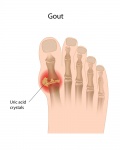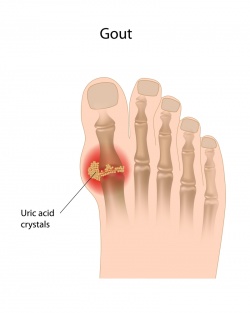Gout
Gout is a recurrent arthritis with monosodium urate crystal deposition in and about the joints and tendons leading to arthritis, soft tissue masses (i.e., tophi), nephrolithiasis, and urate nephropathy. Acute gout most often presents as attacks of pain, erythema, and swelling of one or a few joints in the lower extremities.[1] Gout is often correlated with elevated meat and alcohol consumption. It disproportionately affects men, and 95% of cases are found in males older than 30.[2]
|
Gout | |
| Causes | Dietary Factors, Alcohol, Dehydration, Stress, Heavy Metals |
|---|---|
| See Also | Musculoskeletal Conditions, Hyperuricemia, Obesity, Hypertension, Atherosclerosis |
| Books | Books on Muscle, Joint and Bone Conditions |
| Articles | Articles on Musculoskeletal Conditions |
| Article | Three Cases of Gout, NDNR, 2011 December |
|---|
Naturopathic Assessment
| Article | Gout:A Naturopathic Approach , IHP ; Feb/Mar 2012 |
|---|
Causal Factors
In order to stimulate the innate ability of the body to heal the causes of disease must be identified and addressed. With gout, the causes are variable and include lifestyle and specific physiological factors. A detailed assessment is required to determine which factors are contributing.
Lifestyle
- Increased consumption of high purine containing foods such as organ meats, meat, yeast, poultry, fats, refined carbohydrates, and general caloric excess increase the risk of hyperuricemia and gout.[2], [3]
- Dehydration is a risk factor for hyperuricemia and the development of gout.[4]
Social
- Gout attacks are often correlated with times of increased emotional or physical stress.
Environmental
External
- Injury
- Injuries, especially involving the big toe, can increase the likelihood of a gout attack.
Medical Interventions
- Medical Prescriptions
- Supplementation
Physiology
- Metabolic Derangement
- Hyperuricemia can be caused by the increased production of purines, specific enzyme defects, or glucose 6 phosphatase deficiency.[2]
- Renal Clearance
- Decreased renal clearance of uric acid due to kidney disease or functional impairment, leads to hyperuricemia.[2]
Diagnostic Testing
Gout is often diagnosed at the time of an attack based on a person's symptoms and a physical exam. Follow up testing can confirm the diagnosis.
- Blood Tests: Hyperuricemicia is the primary indication for gout.[5] Other blood tests that are commonly run include: kidney function tests, ferritin, C-Reactive Protein (CRP), LDL
- Other tests The gold standard for confirming a diagnosis of gout is joint fluid aspirate microscopy demonstrating urate crystals. This process can be difficult, and diagnosis is often made solely on clinical presentation.[6]
- The diagnosis is also confirmed if monosodium urate crystals are present in synovial fluid.[1]
Related Symptoms and Conditions
Other conditions associated with gout include:
Characteristics
Gout occurs as acute attacks of joint pain, swelling ,redness and warmth. Over time, if not treated, it can result in a progressive, crippling chronic disease that can damage the kidneys.
- Primary gout accounts for up to 90% of cases and is often classified as idiopathic in conventional medical literature.
- 'Secondary gout accounts for a much smaller percentage of cases and is attributed to other disorders such as renal disease. [2]
Gout may be diagnosed if one of the following criteria is present:[7]
- Monosodium urate crystals in synovial fluid
- Tophi confirmed with crystal examination
- At least six of the following findings:
- Asymmetric swelling within a joint on a radiograph
- First metatarsophalangeal joint is tender or swollen
- Hyperuricemia
- Maximal inflammation developed within one day
- Monoarthritis attack - arthritis symptoms in one joint.
- More than one acute arthritis attack
- Redness observed over joints
- Subcortical cysts without erosions on a radiograph
- Suspected tophi
- Synovial fluid culture negative for organisms during an acute attack
- Unilateral first metatarsophalangeal joint attack
- Unilateral tarsal joint attack
Naturopathic Treatment
The goal of naturopathic treatment is to support and work in tandem with the healing power of the body and to address the causal factors of disease with individual treatment strategies. Gout is typically a chronic disease with acute attacks. The aim of treatment is to decrease the frequency and severity of attacks and to provide symptomatic relief when required.
It is always advisable to work with a naturopathic doctor before engaging in any treatment plan.
Home Care
Home Care strategies include:
- Soaking the feet with alkaline salts can be beneficial.
- Ensure that you wear proper footwear that is not too restrictive, especially during an acute attack.
Lifestyle
Lifestyle recommendations include:
- Achieve ideal body weight,[8] but avoid rapid weight loss diets as this may result in increased uric acid levels.
- Follow a low purine diet.[8], low fat and salt-controlled diet.[9], [5]
- Reduce or eliminate food intolerances, alcohol[8], and simple sugars (honey, fructose, fruits, fruit juices,etc.)[8]
- Consume a diet that focuses on raw, whole, unprocessed food (whole grains, legumes, vegetables, nuts and seeds).[8]. Increase your consumption of strawberries and cherries.
- Ensure an alkaline diet
- Increase fruits such as black cherries, purple grapes, raspberries, blackberries, blueberries, and strawberries.
- Alcohol should be avoided, with the only exception being moderate consumption of dark coloured wines.
- Water intake of 2.5L per day is encouraged to prevent crystallization and promote excretion of uric acid.[4]
Naturopathic Therapies
Naturopathic Therapies for hyperuricemia include:[4], [2]
- Clinical Nutritional Supplementation includes
- Vitamins such as folic Acid, vitamin E, vitamin C
- Minerals such as magnesium
- Amino Acids such as Alanine, Aspartic Acid, Glutamic Acid, Glycine
- Other supplements such as Omega-3 Fatty Acids, Bromelain, Quercetin, Flax Seed Oil
- Herbs such as Burdock (Arctium lappa), Centaury (Centaurium erythraea), Licorice (Glycyrrhiza glabra), Incense tree (Boswellia serrata), Devil's Claw (Harpagophytum procumbens), Meadowsweet (Filipendula ulmaria), Nettle (Urtica dioica), Olive (Olea europaea)
- Gemmotherapies such as Betula alba/pubescens, Betula verrucosa, Fagus sylvatica, Fraxinus excelsior, Populus nigra, Ribes nigrum,Tilia tomentosa, Ulmus campestris
- Both classical and complex homeopathics can be helpful in the treatment of acute and chronic gout.
- Acupuncture is beneficial in the treatment of gout.
References
Reviewed by Iva Lloyd, BScH, RPE, ND [1]
- ↑ 1.0 1.1 1.2 Eggebeen Aaron (2007) Gout: An Update. Am Fam Physician;76:801-8, 811-2.
- ↑ 2.0 2.1 2.2 2.3 2.4 2.5 2.6 2.7 Murray MT, Pizzorno Joseph (2006) Textbook of Natural Medicine 3rd ed Chap 171 Gout Elsevier.
- ↑ 3.0 3.1 3.2 Emmerson BT (Feb 1996) The management of gout. N Engl J Med;334(7):445-51.
- ↑ 4.0 4.1 4.2 4.3 4.4 Demio PC (2007) Rakel: Integrative Medicine 2nd ed Chap 65 Gout Saunders
- ↑ 5.0 5.1 Schlesinger N (2005) Dietary factors and hyperuricaemia. Curr Pharm Des;11(32):4133-8.
- ↑ Chohan S (2011) Bope and Kellerman: Conn's Current Therapy 1st ed Chap 12 Hyperuricemia and Gout Saunders
- ↑ Wallace SL, Robinson H, Masi AT, Decker JL, McCarty DJ, Yu TF. (1977) Preliminary criteria for the classification of the acute arthritis of primary gout. Arthritis Rheum;20:896.
- ↑ 8.0 8.1 8.2 8.3 8.4 Murray Michael 1996 Encyclopedia of Nutritional Supplements, The Essential Guide for Improving Your Health Naturally Prima Publishing
- ↑ 9.0 9.1 Zhu WH, Fang LZ, Chen LY, Chen ZW, Dai HL, Chen JH (Mar 2010) Follow-up study of programmed intervention of hyperuricemia in the prevention and treatment of cardiovascular morbid change Zhonghua Yi Xue Za Zhi;90(10):662-6. PMID:20450723.

